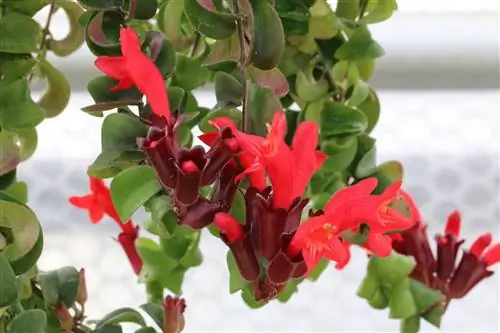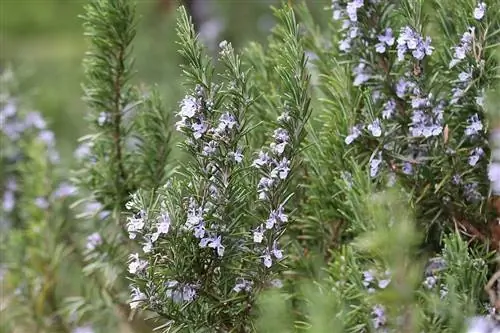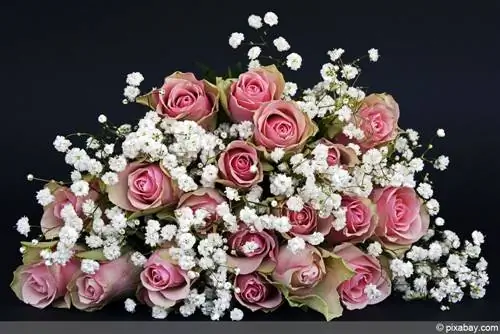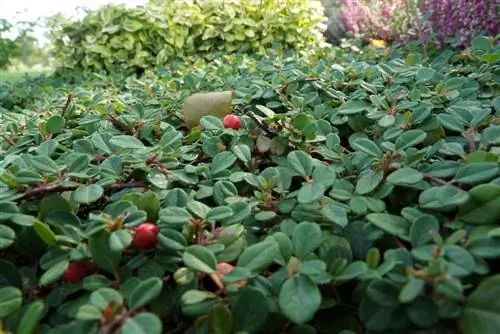- Author admin [email protected].
- Public 2023-12-17 03:39.
- Last modified 2025-01-24 12:45.
With good care, the pubic flower develops into a richly flowering hanging plant that resembles a red-green waterfall. The tubular flowers are often found in whole clusters at the end of the long, hanging shoots. However, it is sometimes not so easy to get the shame flower to bloom because it has a few demands that are difficult to meet in many apartments. Anyone who is enthusiastic about hanging plants and epiphyte stems should also try the pubic flower, which is known as delicate and is naturally a tree-dweller.
Short profile
- botanical name: Aeschynanthus
- other names: golden vine, sensual flower, lipstick flower
- belongs to the Gesneria family
- usually grows as a hanging plant on trees
- shoots between 30 and 150 cm long
- Leaves: slightly different depending on the type
- Flowering period: June to October
- Flower color: usually red, orange or yellow, tubular
Occurrences
Shamflowers, botanically Aeschynanthus, are a genus of plants with around 140 to 185 species within the Gesneria family. Their distribution area extends from Africa to southern Asia and Oceania and is therefore very varied. From a botanical point of view, there are therefore large differences between the different types of pubic flowers in terms of growth habit, flower and leaf shape and flower color. However, all Aeschynanthus species grow as perennial, herbaceous plants. The majority of plants live epiphytically as hanging plants on trees, but there are also terrestrial forms that have a shrub-like appearance.
Location
A pubic flower grows best in a bright location without direct sunlight. The scattered light in the morning and evening hours does not harm the Aeschynanthus. However, the blazing midday sun, especially in the summer months, must be avoided at all costs. Sensual flowers can easily spend the summer outdoors, as long as the temperatures do not drop below 15 degrees at night and they are in a sheltered, partially shaded place on the terrace, balcony or in the garden.
- Light requirements: bright to partially shaded
- no direct sun
- slightly shaded on the south window
- as a hanging plant behind the curtain or further inside the room
- East and West windows
- Temperature: 18 to 22 degrees
- does not tolerate strong temperature fluctuations
- not below 15 degrees or well above 25 degrees
Humidity
Although plant lovers always manage to cultivate the pubic flower in the home even when the humidity is relatively low, the plant actually needs a fairly high level of humidity in order to thrive and produce flowers. If you don't have a winter garden or a special flower window, you should place your pot on a saucer with pebbles and fill it regularly with water. However, the roots must not come into contact with the water, otherwise they could rot. In addition, you should spray the Aeschynanthus daily with room temperature, soft water. Alternatively, you can also set up a humidifier in the room.
Pouring
Between spring and autumn, i.e. in the golden vine's main growing season, you water moderately but regularly. The root ball should be kept slightly moist as long as possible. Between waterings, the bale should only dry out slightly, but not dry out. From October to March the pubic flower is watered more sparingly. Always use water at room temperature, as the heat-loving plant does not tolerate cold irrigation water well. If the climbing or hanging plant begins to bloom in June, it is watered abundantly, but without ever causing waterlogging. Short-term drying is better tolerated by varieties with thick, fleshy leaves than by fine-leaved species.
Fertilize
During the main growing season between the end of April and September, the pubic flower receives some liquid fertilizer for houseplants according to the manufacturer's instructions every fourth watering. If the pubic flower blooms, fertilization continues until the end of the flowering period. For plants that do not flower, the nutrient application is reduced significantly from September onwards, so that fertilization is only carried out once over the winter. If you repot your sensual flower in fresh substrate every year, you don't have to fertilize at all.
Cutting
If the shoots of the sensual flower become too long, they can be shortened in spring. A cut is not necessary. However, dead plant parts should be removed regularly to keep the plant he althy.
- shorten shoots that are too long by a maximum of 2/3
- cut unwoody shoots with a sharp, clean knife
- shorten woody shoots with secateurs
- remove dead shoots
Repotting
Since a pubic flower does not go into a resting phase, it can in principle be repotted all year round. An exception is the flowering period. However, a larger planter only becomes necessary when the roots of the plant already completely fill the pot.
- shake old soil from the roots
- remove dead roots
- If necessary, reduce living roots a little
- possible for hanging plants, for example
- Cut back roots by about 20%
- place in a larger pot with high-quality substrate
- Protect from direct sunlight for three weeks
Tip:
Pubic flowers are often offered in a low-quality substrate made of peat or potting soil with polystyrene beads. This should be replaced immediately with a good substrate.
Substrate
A slightly acidic substrate is ideal for caring for a lipstick flower. If this cannot be offered, the pretty plant cannot develop he althy and strong. As a rule, a high-quality compost-based substrate is sufficient, which on the one hand can store water well, but on the other hand is also well-drained and does not tend to become waterlogged. Simple potting soil is only suitable to a limited extent, as the requirements regarding water and nutrient regulation are not necessarily guaranteed. A good substrate is
- permeable
- humos
- coarse fiber
- toneful
- well water permeable
- pH value: 5.0 to 6.0
It's best to mix the substrate for the pubic flower yourself, because it's not difficult to make. In return, the plant rewards its gardener with optimal substrate conditions with good he alth, vigor and flowering as well as resistance to pests and diseases. A good substrate consists of:
- 4 parts of conventional compost-based potting soil
- 1 part peat substrate
- 2 Share Sand
- 1 part clayey field or garden soil
- fibrous parts made of coconut fiber or pieces of bark
Tip:
It is worth buying test strips for measuring the pH value from a gardening store or pharmacy. The correct soil pH value is essential for the pubic flower to thrive.
Propagate
There are different ways to propagate Aeschynanthus. The easiest way to do this is with cuttings.
Shoot cuttings
It is possible to propagate the pubic flower all year round - except for the flowering period - using head cuttings or shoot cuttings.
- Cut a 15 cm long piece of shoot
- Cut shoot tips
- remove lower leaves
- there are about five sheets left
- scrape or score the outer skin of the shoot at the bottom to about 2 cm
- Stick about three centimeters deep into moist substrate
- Substrate: peat or peat moss with sand (equal parts)
- Temperature: 22 to 28 degrees
- Location: bright, without direct sun
- cover with clear plastic bag
You can tell that roots are forming because the cutting slowly begins to sprout and form new leaves. The plastic bag can be removed and the cutting is watered just enough to keep the soil slightly moist. After about three more weeks, plant 10 to 15 of the cuttings together in a flower pot or hanging basket in substrate suitable for adult plants. Planting should not be delayed too long after rooting. From now on, the young plants should be cared for like adult specimens.
Leaf cuttings
The propagation of the sensual flower by leaf cuttings is a little more tedious but still easy to do - even under normal “living room conditions”. To do this, simply cut off a leaf and stick it about 0.5 to 1 cm deep into moist cactus soil or growing soil. The pot is covered with a clear plastic bag or inverted plastic cup and placed in a warm, bright place in the home (out of direct sunlight). It takes a few months for new plants to grow from the leaves.
Tip:
The whole thing also works with parts of leaves.
Wintering
Under moist and warm conditions, the pubic flower does not go into hibernation and grows all year round. However, since the light available decreases in the winter months, the plant's growth also slows down significantly. Watering is therefore carried out more sparingly during this time. Even during the cold season, temperatures must never fall below 16 degrees. Year-round cultivation conditions between 18 and 22 degrees are ideal.
Tip:
Lazy flowering specimens should be hibernated in a light place at 16 degrees in winter. The following spring the plants sprout again vigorously and usually produce flowers from June onwards.
Popular types of pubic flower
While most pubic flowers form hanging shoots, there are also a few species that grow upright.
Hanging, creeping or climbing pubic species
These species grow well in hanging baskets or on an elevated site. Alternatively, the shoots can also be guided upwards using a climbing aid.
- Aeschynanthus bracteatus: scarlet colored flowers, grows climbing or hanging
- Aeschynanthus japhrolepsis: very small, shiny light green leaves, orange-red flowers
- Aeschynanthus longicaulis: grows semi-creeping with shoots up to 90 cm long, axillary or terminal orange-red flowers with a green calyx, green-white marbled leaves
- Aeschynanthus mormoratus (also zebrinus, spotted lipstick flower): with its marbled leaves also popular as an ornamental foliage plant, grows creeping with shoots up to 90 cm, with good care single greenish yellow flowers all year round (sometimes referred to as A.longicaulis confused)
- Aeschynanthus pulcher: epiphytic climbing plant with shoots up to 80 cm long with slightly smaller leaves, terminal panicles in strong red with a yellow throat, the variety 'Twister' is particularly distinctive with its curled leaves
- Aeschynanthus radicans: initially slightly rising shoots, later overhanging, slightly woody, red tubular flowers with creamy white stripes, a special variety is the A. radicans 'Variegata' with green-white leaves and deep red flowers
- Aeschynanthus speciosus (Syn. speciosum): emerging, later overhanging shoots up to 60 cm long, orange to scarlet flowers, often arranged in clusters of 6 to 20 individual flowers, a popular variety is the A. speciosus 'Mona Lisa ' with its strong red flowers
Upright growing pubic flower species
- Aeschynanthus evardii: up to 40 cm tall, yellow-red flowers
- Aeschynathus hildebrandii (also hillbrandii): most common variety with slightly overhanging shoots, up to 30 cm tall
Diseases and pests
Especially when the humidity is low in winter, the pubic flower becomes susceptible to the usual pests of houseplants. It should therefore be checked regularly for infestation. The earlier the pests are discovered, the easier it is to combat them.
- Aphids
- Spider mites
- Thrips
Care errors
The pubic flower should under no circumstances be moved or placed in a different place, especially during flowering. In this case, the plant acknowledges even the smallest changes by shedding buds and flowers.
- Heat or cold stress: is usually manifested by yellow, withered leaves. After a cold shock, for example from a tilted window or excessive ventilation in winter, the otherwise leathery leaves become soft and limp, sometimes taking on a transparent sheen
- irrigation water that is too cold: light brown spots on the leaves
- Falling leaves: in summer this indicates that the root ball is too dry, in winter it indicates cold stress
- yellow leaf tips: temperature too high and humidity too low
- Mold on substrate or plant: too much irrigation water, roots may rot, urgently plant in fresh substrate and cut dead roots
Conclusion
Although the pubic flower is considered difficult to cultivate, with a little background knowledge it thrives even with inexperienced hobby gardeners. On the one hand, the Aeschynantus plant should be given a partially shaded location with high humidity that offers temperatures between 18 and 22 degrees all year round. On the other hand, a special substrate is necessary, the pH of which should be checked regularly. pH values between 5.0 and 6.0 are ideal. If the conditions are met, it will also produce lush flowers.






